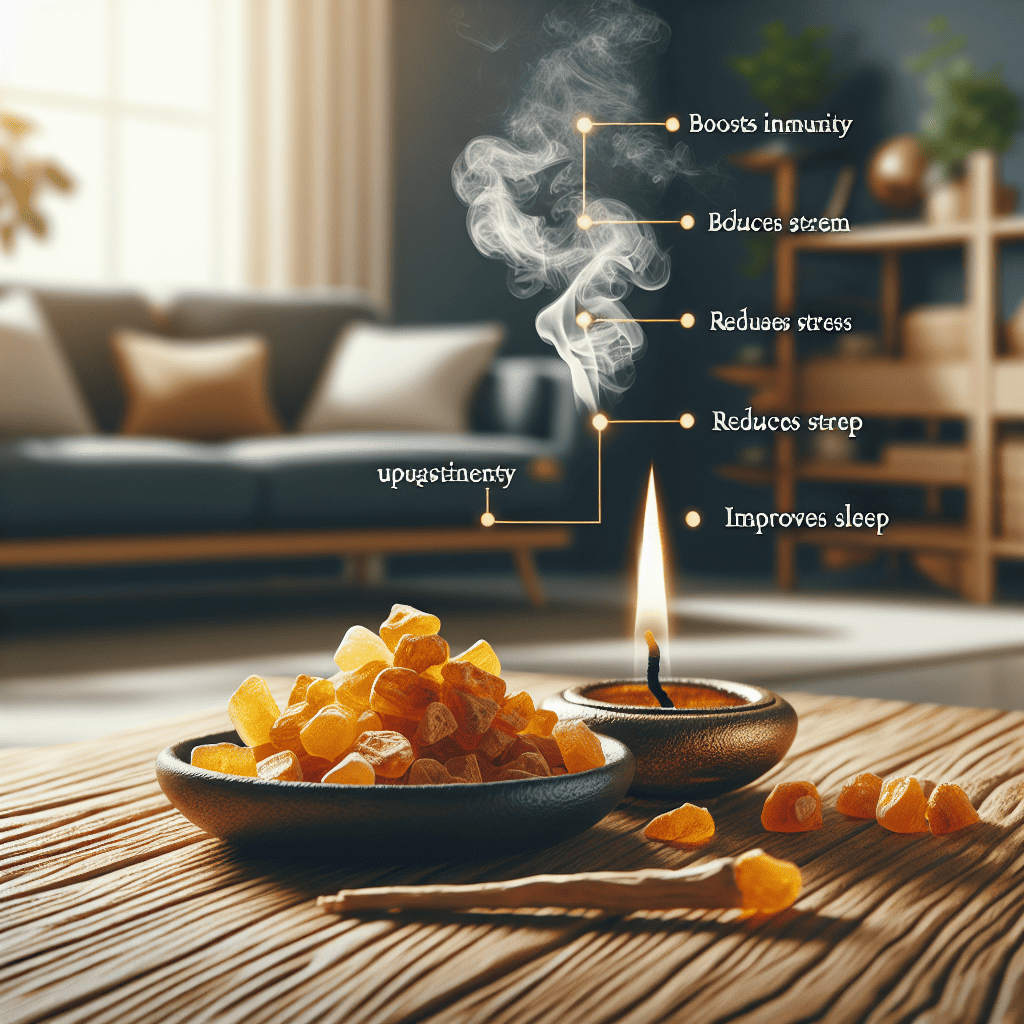Introduction: Frankincense, derived from the gum of the Boswellia serrata tree, is a substance renowned for its numerous health benefits. This article delves into the efficacy of frankincense, its safety considerations, and distinguishes it from gum arabic.
Table of Contents
- Benefits of Frankincense by Degree of Effectiveness
- Degree of Safety and Caveats
- The Difference Between Frankincense and Gum Arabic
Benefits of Frankincense by Degree of Effectiveness
This section categorizes the health benefits of frankincense based on their varying degrees of effectiveness.
- Possible Effective:
Frankincense, also known as olibanum, has been studied for its potential health benefits, particularly in managing certain health conditions. Research suggests that frankincense may have anti-inflammatory properties, making it a promising natural remedy for degenerative arthritis. In degenerative arthritis, also known as osteoarthritis, the cartilage within the joints breaks down, leading to pain, stiffness, and swelling. By reducing inflammation, frankincense may help alleviate the symptoms associated with this condition and improve joint function.
In addition to its potential benefits for degenerative arthritis, frankincense has also shown promise in managing ulcerative colitis. Ulcerative colitis is a chronic inflammatory bowel disease that causes inflammation and ulcers in the digestive tract, leading to symptoms such as abdominal pain, diarrhea, and fatigue. Studies have indicated that the anti-inflammatory properties of frankincense may help reduce inflammation in the gut and alleviate symptoms of ulcerative colitis. By modulating the immune response and potentially reducing inflammation, frankincense could offer a complementary approach to managing this challenging condition.
While more research is needed to fully understand the mechanisms behind frankincense’s effects on degenerative arthritis and ulcerative colitis, the preliminary findings are encouraging. Incorporating frankincense into a holistic treatment plan, under the guidance of a healthcare provider, may offer individuals with these health issues a natural and potentially effective option for symptom management. As with any supplement or alternative treatment, it is essential to consult with a healthcare professional before using frankincense, especially if you have underlying health conditions or are taking medications, to ensure its safety and appropriateness for your individual needs.
- Inadequate Evidence:
Frankincense has been used for centuries in traditional medicine for various ailments, but its effectiveness as a treatment option for certain health conditions lacks substantial evidence. One such condition is asthma, a chronic respiratory disease that causes inflammation and narrowing of the airways, leading to difficulty in breathing. While some studies suggest that frankincense may have anti-inflammatory properties that could potentially benefit asthma patients, more rigorous scientific research is needed to confirm its effectiveness and safety in the treatment of asthma.
Another health condition where the effectiveness of frankincense as a treatment option lacks strong scientific evidence is brain tumors. Brain tumors are abnormal growths of tissue in the brain that can be either cancerous or non-cancerous. There is limited research on the use of frankincense for brain tumors, and current studies are inconclusive. More clinical trials and studies are necessary to determine whether frankincense can play a role in the treatment of brain tumors or if other proven treatments should be prioritized.
Furthermore, conditions like cluster headaches, collagenous colitis, Crohn’s disease, and rheumatoid arthritis also do not have enough concrete evidence supporting the use of frankincense as a reliable treatment. Cluster headaches are severe headaches that occur in cyclical patterns, collagenous colitis is a type of inflammatory bowel disease, Crohn’s disease is a chronic inflammatory condition of the gastrointestinal tract, and rheumatoid arthritis is an autoimmune disorder causing joint inflammation. While frankincense is believed to have anti-inflammatory and analgesic properties that could potentially help with these conditions, more clinical research is essential to determine its safety, efficacy, and recommended dosages before it can be considered a viable treatment option.
Degree of Safety and Caveats
This section focuses on the safety considerations and precautionary measures associated with using frankincense.
- Degree of Safety:
Frankincense, also known as olibanum, has been used for centuries for its aromatic properties and in various traditional medicines. While generally considered safe for most people when used in appropriate amounts, there are potential risks and safety concerns to be aware of. One of the primary safety concerns with using frankincense is the potential for skin irritation. Undiluted or concentrated forms of frankincense oil applied directly to the skin can lead to irritation, redness, or allergic reactions in sensitive individuals. It is essential to always dilute frankincense oil with a carrier oil before applying it to the skin to reduce the risk of adverse reactions. Performing a patch test on a small area of skin before using frankincense topically can help identify any potential sensitivities.
Another safety aspect to consider when using frankincense is the potential for interactions with certain medications. Frankincense oil can affect the metabolism of certain drugs, especially those processed by the liver. If you are taking any medications, particularly for conditions like blood clotting disorders or chronic illnesses, it is crucial to consult with a healthcare professional before using frankincense to avoid any harmful interactions. Additionally, pregnant women should exercise caution when using frankincense, as there is limited research on its safety during pregnancy. It is advisable to consult with a healthcare provider before using frankincense oil during pregnancy or while breastfeeding to ensure safety for both the mother and the baby.
Lastly, when using frankincense for aromatherapy purposes, it is important to practice proper ventilation to avoid inhaling high concentrations of the essential oil, which can cause respiratory issues or allergic reactions, especially in individuals with asthma or other respiratory conditions. Using a diffuser with the recommended amount of frankincense oil and ensuring that the room is well-ventilated can help minimize the risk of adverse effects. Overall, while frankincense can offer various benefits when used correctly, it is essential to be aware of these safety considerations and potential risks to ensure a positive and safe experience when utilizing this ancient remedy.
The Difference Between Frankincense and Gum Arabic
Distinguishing between frankincense and gum arabic, elucidating their disparities and sources.
- Explanation of Differences:
Frankincense and gum arabic are both natural substances with distinct properties and uses. Frankincense is a resin obtained from the Boswellia tree, primarily found in regions like the Arabian Peninsula, India, and Africa. It has been used for centuries in religious ceremonies, perfumes, and traditional medicine. In contrast, gum arabic, also known as Acacia gum, is a natural gum made from the hardened sap of the Acacia tree. It is commonly sourced from species of Acacia trees native to regions in Africa, particularly the Sahel region. Gum arabic is widely used in the food and beverage industry as a stabilizer, emulsifier, and thickening agent.
One of the key differences between frankincense and gum arabic lies in their composition and chemical properties. Frankincense mainly consists of resin acids, essential oils, and other volatile compounds that give it a distinct aroma when burned as incense. On the other hand, gum arabic is composed of complex polysaccharides, including arabinose and galactose sugars, making it a valuable additive in various industries. While frankincense is primarily valued for its aromatic and therapeutic properties, gum arabic is prized for its functional properties such as its ability to improve texture, increase viscosity, and extend shelf life in food products.
Furthermore, the cultural significance and traditional uses of frankincense and gum arabic distinguish them in terms of their historical and spiritual contexts. Frankincense has a rich history dating back to ancient civilizations like the Egyptians and Babylonians, who used it in religious rituals and embalming practices. It continues to be highly revered in many cultures for its symbolic and ceremonial importance. In comparison, gum arabic has been utilized for its practical applications in industries like food, pharmaceuticals, printing, and cosmetics. Despite their differences, both frankincense and gum arabic hold unique roles in various sectors, showcasing the diverse ways in which natural substances can be harnessed for different purposes.
Composition of Frankincense:
Frankincense, also known as olibanum, is a resin obtained from trees belonging to the genus Boswellia. The resin contains a complex mixture of compounds, including essential oils, soluble gum, and terpenes. Among these components, Boswellic acid is recognized as a significant biologically active compound that contributes to the various health benefits associated with frankincense. This acid is known for its anti-inflammatory properties and is often used in traditional medicine for treating conditions such as arthritis, asthma, and inflammatory bowel diseases.
The essential oils found in frankincense are particularly valued for their aromatic qualities and therapeutic effects. These oils are extracted through a steam distillation process from the resin of the Boswellia trees. They are known to possess antimicrobial, anti-inflammatory, and mood-enhancing properties. The distinct fragrance of frankincense essential oil also makes it a popular choice in aromatherapy practices, where it is believed to promote relaxation, reduce stress levels, and enhance overall well-being.
Terpenes, another component of frankincense, are organic compounds that contribute to the unique scent and flavor of the resin. They are widely found in various plant species and are known for their potential health benefits. Terpenes exhibit antioxidant properties and may have anti-inflammatory and pain-relieving effects. These compounds, along with Boswellic acid and essential oils, work synergistically to provide frankincense with its therapeutic properties, making it a valuable natural remedy with a long history of use in traditional medicine and religious ceremonies.
Health Benefits and Uses:
Frankincense, derived from the resin of the Boswellia serrata tree, has been used for centuries in various cultures for its potential health benefits. One significant advantage of frankincense is its anti-inflammatory properties, which have shown promising results in managing degenerative arthritis. The active compounds in frankincense, such as boswellic acids, have been found to possess anti-inflammatory effects that may help reduce pain, swelling, and stiffness in the joints. These benefits make frankincense a popular natural remedy for alleviating symptoms of conditions like osteoarthritis and rheumatoid arthritis.
In addition to its anti-inflammatory benefits for arthritis, frankincense has various applications that extend to promoting overall well-being. The resin is commonly used in aromatherapy for its calming and grounding effects on the mind and body. Inhalation of frankincense essential oil through diffusers or steam inhalation is believed to help reduce stress, anxiety, and improve mental clarity. Moreover, frankincense is also utilized in skincare products for its potential anti-aging and skin-regenerating properties. The resin’s ability to improve skin tone, reduce the appearance of fine lines and wrinkles, and support overall skin health makes it a sought-after ingredient in cosmetics and skincare routines.
Furthermore, frankincense is recognized for its potential to support respiratory health. The expectorant properties of frankincense essential oil may help clear congestion, alleviate symptoms of coughs and colds, and support healthy respiratory function. The oil can be used in steam inhalation or diluted in carrier oils for chest rubs to aid in relieving respiratory discomfort. Additionally, frankincense has been studied for its antimicrobial properties, which may help fight off infections and boost the immune system. These diverse benefits of frankincense showcase its versatility in promoting health and well-being across various domains, highlighting its value as a natural remedy with a long history of traditional use.
Types of Frankincense:
Frankincense is derived from the resin of Boswellia trees and comes in different types, with each type having unique benefits and uses backed by scientific evidence. One common type of frankincense is Boswellia Serrata, which has been extensively studied for its anti-inflammatory properties. Research suggests that Boswellia Serrata can help reduce inflammation and pain associated with conditions like osteoarthritis and other inflammatory diseases. It has been found to inhibit the production of pro-inflammatory compounds, providing relief to those suffering from chronic inflammatory conditions.
Another type of frankincense, known as Boswellia Carterii, is valued for its potential anti-cancer effects. Scientific studies have shown that Boswellia Carterii contains compounds that can induce cancer cell death and inhibit the spread of tumors. Research also suggests that this type of frankincense may help enhance the efficacy of certain chemotherapy drugs, making it a promising adjunct therapy for cancer patients. Additionally, Boswellia Carterii has been investigated for its potential benefits in managing asthma and improving respiratory function due to its anti-inflammatory properties.
Lastly, Boswellia Sacra, also known as Sacred Frankincense, is renowned for its mood-boosting and stress-relieving effects. Scientific evidence supports the use of Boswellia Sacra in aromatherapy for promoting relaxation, reducing anxiety, and improving overall mental well-being. Studies have shown that the aroma of Boswellia Sacra essential oil can have a calming effect on the nervous system, leading to reduced stress levels and enhanced mood. Additionally, this type of frankincense has been explored for its potential anti-depressant properties, making it a valuable natural remedy for those struggling with mood disorders.




